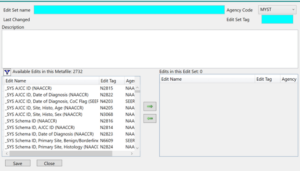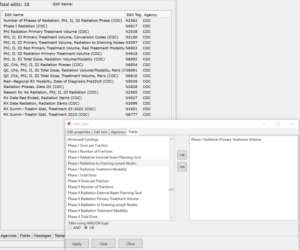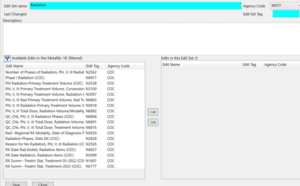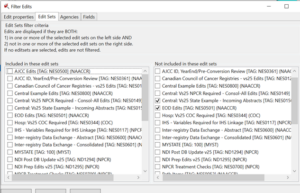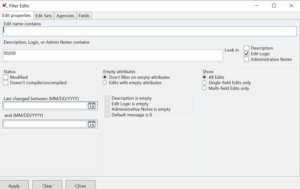
Standardized edit sets are a critical part of ensuring cancer registry data quality. At the last count, the NAACCR Edits Metafile contained 2,732 edits. Many of these edits are meant to work together (for example, one edit checks for valid values and another ensures the field is either blank or not blank based on standard setter requirements). Other edits are in direct conflict and should never be used on the same case (one edit allowing blank and another not allowing blank for the same data item). Standard setters also have different requirements by date and data item.
The 2,732 edits are grouped together into 26 purposeful edit sets. The edits sets allow edits to work together to apply a coordinated set of standards and avoid logic conflicts. The same edits can be used in multiple edit sets, and edit sets allow choice in data fields and level of editing to apply to the data. An edit set may include one to hundreds of edits that a software program can use with a single call to the edit set.
A link to the the Developing Central Registry Edits Metafiles and a link to the EditWriter software are available on the NAACCR Edits Metafile Page.
EDIT SETS
The standard NAACCR metafile includes edit sets that run on routinely reported data based on standard setter requirements:
- NES0127 – Canadian Council of Cancer Registries – Vs25 Edits
- NES0149 – Central: Vs25 NPCR Required – Consol-All Edits
- NES0150 – Central: Vs25 State Example – Incoming Abstracts
- NES0344 – Hosp: Vs25 COC Required
- NES0445 – SEER: Hospital Edits
- NES0344 – SEER: Vs 25 Transmit Edits
NES0149 and NES0344 are intended for cases that are submitted to NPCR and SEER from state or regional registries, while NES0150 and NES0445 are examples of edit sets for facilities reporting to the NPCR or SEER state and regional registries.
All other edit sets in the NAACCR metafile are special purpose groups of edits. Many of these are organized around types of data items, allowing the edits to be readily identified by any registry deciding to collect and edit items which are not included in their routine submission:
- NES0500 – AJCC Edits
- NES0501 – EOD Edits
- NES0052 – Path Items
- NES0502 – SSDI Valid Value Edits
- NES0277 – Survival Field Edits
- NES0001 – Text Edits
Quality control edits apply logic that may not always be resolved so may not be included in routine data submissions:
- NES0700 – NPCR Treatment Checks
- NES0003 – Quality Control Edits-Central Registry
Other edit sets are designed to edit across multiple data items but for a limited data use:
- NES0361 – AJCC ID, Year_End/Pre- Conversion Review
- NES0117 – IHS – Variables Required for IHS Linkage
- NES0600 – Inter-registry Data Exchange – Abstract
- NES0601 – Inter-registry Data Exchange – Consolidated
- ND1294 – NDI Post DB Update v25
- ND1295 – NDI Prep Edits v25
- NES0365 – Schema ID, Year_End/Pre-Conversion Review
- NES0351 – Vendor _SYS Edits
The final group of edit sets demonstrate other uses. NES0800 contains sample edits for central registries to use as templates for their own edits. The three pre-2016 edit sets allow central registries to choose AJCC TNM edits based on whether or not their reporting facilities were required to convert pre-2016 data with “c” and “p” TNM component descriptors.
- NES0800 – Central Example Edits
- NES0336 – Pre2016 c,p mixed bag
- NES0337 – Pre2016 c, p required
- NES0338 – Pre2016 no c,p in codes
NEW EDIT SETS
ND1294 and ND1295, edit sets used on data items pre- and post-linkage with the National Death Index, were previously in a separate metafile. Adding them to the NAACCR metafile in v25 allows standard edits to be used as they are updated, without the necessity to repeat the process in a second metafile. Only one edit was added to the standard metafile from these edit sets.
NES0700 is new for v25, bringing in edits that NPCR created to check on completeness of treatment data. The edits in this edit set demonstrate logic used to promote data collection. NES0800, also new in v25, is an experiment in offering edit examples and tables that registries could adapt for their own use with some work.
NES0445, SEER Hospital Edit Set is new for v25, and NES0361 and NES0365, AJCC ID and Schema ID edit sets are new for v25A. NES0445 was inspired by discussion within the Edits Work Group that the SEER Transmit edit set, intended for central registries submitting data to SEER, was not appropriate for hospital registries submitting data to the central registries. The edit set was composed by copying the SEER Transmit Edit Set, removing edits for data items only collected at the central registry, and adding edits for hospital data items listed as required by SEER in the Required Standards Table in the NAACCR Data Standards and Dictionary Dictionary.
NES 0361 and NES0365 identify cases where AJCC ID or Schema ID is not correct by diagnosis year for the coded site, histology, and if required behavior, age, sex, and schema discriminator. These edits could be used pre-conversion if a conversion involves a change in AJCC ID or Schema ID, or for a year-end coding review to identify ID assignments and any related coding that require correction.
These last two edit sets were created in response to an inquiry from Ruth Li, ODS, a registrar from Ohio, where routine edits had failed to identify a problem in coding between TNM Edition Number and AJCC ID, where data conversion dependent upon TNM Edition Number was not correctly performed. All the edits needed to identify the original coding issue are in place in the metafile but were not gathered into the same edit set. The edit sets were copied from edits in the Vendor _SYS Edit Set, with the addition of four edits for the AJCC ID edit set.
CREATING NEW EDIT SETS
Edit sets and edits in the standard metafile are available for registries to use and customize to meet their specific data collection requirements and enhance the quality of their data. The standard metafile has created the body of edits and edit sets and continues to expand both, as reporting standards evolve and as registries request assistance. When registry requests lead to edits and edit sets applicable to the general registry population, they are brought into the standard metafile.
The questions to ask when considering custom edit sets:
- What are the data items of interest?
- What edits apply to these data items?
- What level of editing is required (valid value versus interfield consistency)?
- Are these edits best applied in a limited edit set, or could they be moved into routine editing?
EditWriter provides edit filters to help identify edits of interest, and a form to create new edit sets and populate them with selected edits.
Using EditWriter: Create a new edit set by clicking on the Edit Sets tab on the lower menu line, entering a name for the edit set, an agency code, and edit set tag (number), and clicking on Save. All available edits will show up in the left-hand column of the form. The arrows are used to move selected edits between the two columns, either individually or in groups.
EDIT SET SCENARIOS
Three scenarios are presented here as examples of creating custom edit sets using existing edits in the standard metafile:
- Pathology Report Review
Registry has a limited data stream of pathology reports and wishes to edit patient identification; site, histology, behavior, and sex and age if available; pathology report date, ordering facility, report number, and report type. Registry selects edits based on edit name and review. Registry adds edits to edit set manually.
Edits selected:
- N1431 – Name—First (NPCR)
- N0155 – Name—Last (NPCR)
- N0239 – Name—Middle (NPCR)
- N1034 – Date of Birth (NAACCR)
- N0026 – Age at Diagnosis (SEER AGEDX)
- N0012 – Sex (SEER Sex)
- N0007 – Primary Site (SEER SITE)
- N0795 – Histologic Type ICDO3 (SEER)
- N0469 – Behavior ICDO3 (COC)
- N7040 – Primary Site, Morphology-Type, Beh ICDO3, 2024 (SEER)
- N1162 – Path Date Spec Collect 1 (NAACCR)
- N1147 – Path Ordering Fac No 1 (NAACCR)
- N1152 – Path Report Number 2 (NAACCR)
- N1137 – Path Report Type 1 (NAACCR)
Using EditWriter: With a limited number of edits involved, the easiest way to add edits to the edit set is by clicking on the Cross-References tab for each edit and clicking in the box for the appropriate edit set.
- Phase I Radiation Primary Treatment Volume
Registry decides to do a quality review of coding of the data item Phase I Radiation Primary Treatment Volume. As the first step in study, registry determines if any issues with current edits. Registry also evaluates QC edits for usefulness. Registry selects all edits including this data item for review, using Edits Filter. Registry moves all filtered edits into new a edit set.
Using EditWriter: Clicking on the Filter tab in the second to top menu line when edits are displayed brings up filter options for Edit properties, Edit Sets, Agencies, and Fields. Clicking on Fields displays the list of data items in the metafile. Moving alphabetically through the list of fields, the registry selects Phase I Radiation Primary Treatment Volume and moves this field to the right column, then clicks on Apply.
The list of edits using this data item is displayed on the Edits tab. Opening the Edit Set form for the new edit set, a filter icon appears at the top of the left-hand column that shows all the available edits in the metafile. Clicking on the filter icon displays the filtered edit list. The registry selects all filtered edits, by highlighting the first edit in the list and holding the shift key down and clicking on the last edit in the left. Clicking on the right-pointing arrow moves all the highlighted edits into the right-hand column and into the new edit set.
- Site-Specific Data Items for Schema ID 00200 (Colorectal)
Registry reporting to NPCR is interested in collecting additional SSDI items for colorectal cancers, Schema ID 00200. Registry filters edits on Edit Sets, edits not included, and 00200 in Edit Logic. The registry filters on edits not included in the Central State Example as that is their basic edit set, and filters on edits not included in EOD Edits as they do not collect EOD data items. Registry decides to test edits before including them in routine editing, so creates separate edit set. Registry uses filtered edit list to create edit set, but omits QC and CCCR edits, SEER edits that duplicate CoC edits, and edits for surgery 03-2022.
Using EditWriter: The registry uses two filters for Edits to identify edits of interest. The registry selects the Edit Sets filter for Edits, and from the boxes in the right-hand column for edits not included in edit sets clicks in Central: Vs25 State Example and EOD Edits. On the Edit properties filter screen the registry enters “00200” in the space for Description, Logic, or Admin Notes contains, and clicks in the Edit Logic box. The registry then clicks on Apply, to bring up the filtered list of edits meeting the selected requirements. The registry moves the filtered list into the new edit set, but on review moves back edits as noted above.
EditWriter Tools
These scenarios demonstrate options for identifying edits to include in custom edit sets and options for moving the edits into edit sets. The edit filter options work together across the four filter tabs, and the edit set screen allows display of the filtered edit list. All the edits in either column of the edit set form can be selected and moved as a group or moved individually into the other column.
Edit Set reports list all edits in a single edit set. The Excel: Edits/Edit Sets report option provides a list of all edits in a metafile by Edit Set, allowing an easy comparison of edit use by standard setters. Edit sets can be created for limited time quality studies, or maintained for use on routine data submissions. Including special purpose edit sets in the standard metafile allows standard edits to be used for multiple purposes, eliminating maintenance of common edits across metafiles.
Custom edit sets, as all other custom objects in a metafile, are easy to create, but more work to maintain. Any standard edits included in a custom edit set will be updated if they are updated in a revision of the standard metafile. If any standard edits are deleted, care must be taken to not bring the deleted edit into the updated metafile through importing the custom edit set. If any standard edits are replaced or significantly modified, the edits in the custom edit set must be reviewed to make sure they still serve their purpose.
Edit sets reflect and respond to standard setter requirements. They organize data review. They provide economies for edit use and comparison. EditWriter features facilitate their creation and display. Edit sets serve multiple functions. The Edits Work Group strives to create edit sets of broad use for the registry community, and always welcomes suggestions from the community that increase the contributions of the editing process to data quality.
Tags: Featured, Operations, assurance, control, edit, edit sets, edits, quality, registry, surveillance
What to Read Next
Meet Our New Director for the Texas Cancer Registry, Natalie Archer
Please join us in welcoming Natalie Archer, PhD, to the NAACCR community. Natalie is the new Director of the Texas…
Data Modernization in Action: Childhood Cancer Survivorship, Treatment, Access, and Research (STAR) Act
The STAR Project is part of the CDC’s bigger picture for data modernization. The Childhood Cancer Survivorship, Treatment, Access, and…



